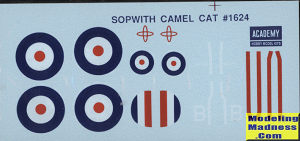
Academy 1/72 Sopwith Camel
| KIT #: | 12447 |
| PRICE: | $10.00 or less |
| DECALS: | One option |
| REVIEWER: | Scott Van Aken |
| NOTES: | 1984 release |

| HISTORY |
The Sopwith Camel is a British First World War-era single-seat biplane fighter aircraft that was introduced on the Western Front in 1917. It was developed by the Sopwith Aviation Company as a successor to the Sopwith Pup and became one of the best known fighter aircraft of the Great War.
The Camel was powered by a single rotary engine and was armed with twin synchronized Vickers machine guns. Though difficult to handle, it was highly manoeuvrable in the hands of an experienced pilot, a vital attribute in the relatively low-speed, low-altitude dogfights of the era. In total, Camel pilots have been credited with downing 1,294 enemy aircraft, more than any other Allied fighter of the conflict. Towards the end of the First World War, the type also saw use as a ground-attack aircraft, partly because the capabilities of fighter aircraft on both sides had advanced rapidly and left the Camel somewhat outclassed.
The main variant of the Camel was designated as the F.1. Other variants included the 2F.1 Ship's Camel, which operated from aircraft carriers; the Comic night fighter variant; and the T.F.1, a "trench fighter" armoured for attacks on heavily defended ground targets. A two-seat variant served as a trainer. The last Camels were withdrawn from RAF service in January 1920, but continued in service with other nation's air arms.
| THE KIT |
This kit is quite reminiscent of the ESCI Camel that I built decades ago. It is a fairly basic kit, consisting of fewer than 20 pieces. There is no real interior, just a molded in seat in each fuselage half. No pilot, which would at least have helped fill the space.
The kit looks to be fairly accurate and well molded. The cowling has an engine face molded into it. The two machine guns are very basic and a single piece that fits atop the fuselage. Landing gear is fairly complex consisting of five pieces. Each of the wings, tailplanes and fin are a single piece. For each wing, the interplane struts are molded as a single piece with connecting pieces that slot into grooves in the wing. The cabane struts are a similar construct. Probably the most fiddly part of the build may be attaching the landing gear as there are simply pins on the struts that fit into holes in the lower fuselage.
 Instructions
are five well drawn steps. Markings are for a single aircraft as shown on the
box art. There is no painting information, but the undersurface of the wings and
tailplanes is linen. The nose section is white while the rest is the standard
RFC/RAF olive green. Decals look to be quite well done. I'm sure there are
aftermarket if one is so inclined. No rigging diagram is provided, but one can
use the box art for that.
Instructions
are five well drawn steps. Markings are for a single aircraft as shown on the
box art. There is no painting information, but the undersurface of the wings and
tailplanes is linen. The nose section is white while the rest is the standard
RFC/RAF olive green. Decals look to be quite well done. I'm sure there are
aftermarket if one is so inclined. No rigging diagram is provided, but one can
use the box art for that.
| CONCLUSIONS |
This looks like a true weekend build. In fact, the entire assembly process probably won't last an hour. Rigging will take time if so inclined. I'm not well versed in things WWI so am not sure what is better than this one, but what is there is a good start.
| REFERENCES |
https://en.wikipedia.org/wiki/Sopwith_Camel
October 2023 Copyright ModelingMadness.com.
All rights reserved. No reproduction in part or in whole without express
permission from the editor. If you would like your product reviewed fairly and fairly quickly, please
contact the editor or see other details in the
Note to
Contributors. Back to the Main Page
Back to the Review
Index Page
Back to the Previews Index Page